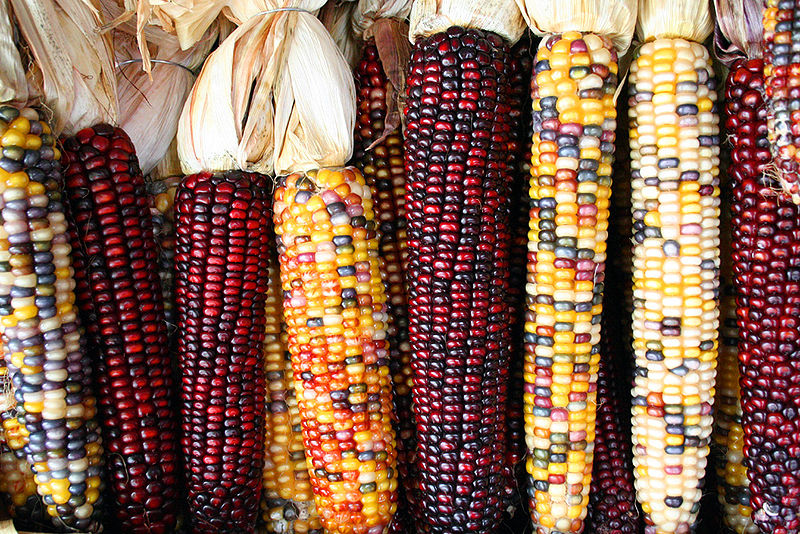
Maize or Indian corn is a vegetable and aa grain.
- botanical information
- origin
- history
- part used
- nutritional information
- selection
- storage
- astrological correspondences
- magick correspondences and uses
- Goddesses and deities
- Chinese herbology
- cautions and contraindications
botanical information:
Botanical name: Zea mays
Use the botanical name when ordering seeds (bulbs, etc.) or when looking up information in the library. Common names vary by nation, culture, and region, and sometimes the same common name is applied to different plants.
Common (American English) name: corn, Indian corn, maize
British name: maize
French name: maïs
German name: mais
Italian name: granturco, mais
Spanish name: mais
Vietnamese name: ngô
Family: Poaceae (grasses); subfamily Panicoideae
origin:
Origin: Highlands of Mexico. Discovered approximately 1225 B.C.E.
history:
History: Prior to Columbus there were approximately 300 varieties of corn growing in North America. By the year 2000 only 16 varieties of corn accounted for more than 70% of the corn being grown in the United States.
Prior to the invention of toilet paper, used corn cobs were used to wipe the ass. Hence, the term “corn hole”.
part used:
|
Part Used (corn silk): Dried silk, whole or powdered. Information courtesy of Mountain Rose Herbs |
nutritional information:
Americans eat an average of 42 pounds of high fructose corn syrup a year. Corn is used to create most junk food (including the sweetener for soda and candy).
A 2007 Ohio State University study showed that the anthocyanins in purple corn (a source of the deep purle color) stopped the growth of colon cancer cells. Purple corn anthocyanin pigments completely stopped the growth of cancer cells grown in laboratory dishes, killed nearly 20 percent of the cancer cells, and had no harmful effect on healthy cells.
“Oh, my fellow men, do not defile your bodies with sinful foods. We have corn, we have apples bending down the branches with their weight, and grapes swelling on the vines. There are sweet-flavored herbs, and vegetables which can be cooked and softened over the fire, nor are you denied milk or thyme-scented honey. The earth affords a lavish supply of riches, of innocent foods, and offers you banquets that involve no bloodshed or slaughter; only beasts satisfy their hunger with flesh, and not even all of those, because horses, cattle, and sheep live on grass.”, Pythagoras (Greek mathematician).
See also Chinese herbalism below for Chinese gender and Chinese flavor.
selection:
Frozen sweet corn has the number three (3) lowest pesticide load of 45 common fruits and vegetables studied in 2006 by the Environmental Working Group and is therefore a food that can be purchased conventionally-grown when organic isn“t available. The EWA explains, “While washing and rinsing fresh produce may reduce levels of some pesticides, it does not eliminate them. Peeling also reduces exposures, but valuable nutrients often go down the drain with the peel. The best option is to eat a varied diet, wash all produce, and choose organic when possible to reduce exposure to potentially harmful chemicals.”
According to USDA and FDA tests on commercially grown foods collected between 2000 and 2005, sweet corn (frozen) has a 3.8% (percentage) of samples tested with detectable pesticides, a 0.0% (percentage) of samples with two or more pesticides, an 0.0 average number of pesticides found in a sample, an average of 0.005 parts per million of all pesticides found, and 3 different pesticides found in use growing corn. These toxic pesticides don’t apply to organic foods.
storage:
Storage: Eat corn within two days of purchase.
astrological correspondences:
![]() Astrological planet: Sun
Astrological planet: Sun
magickal correspondences and uses:
Gender: feminine (traditional western European magickal gender)
Western element: fire
deities associated with maize (corn):
- Xochipilli (Aztec Deity)
Chinese herbalism:
Chinese gender: neutral
cautions and contraindications:
Cautions and contraindications: Corn silk and corn seeds are believed to be safe.
Allergies: Maize (corn) contains lipid transfer protein. This undigestable protein survives cooking and has been linked to rare allergy to corn in humans. The allergic reaction can include skin rash, swelling or itching of mucus membranes, diarrhea, vomiting, asthma, and possibly anaphylactic shock. Persons with corn allergy almost always also have peach allergy.
Organic Labels: The Bush administration’s USDA has announced that they will help large American food corporations increase their profits by purposely deceiving the American public by putting non-organic foods into foods labelled as being organic. Under U.S. law, for foods to labelled as organic, crops must be grown without chemical fertilizers, sewage sludge, bioengineering, or pesticides and animals must be raised without antibiotics and growth hormones and given access to the outdoors. The USDA has decided that 43 non-organic ingredeients can be added to foods labelled as organic. To protest this decision, go to Organic Consumers Association. One of the non-organic ingredients is corn starch.

digital image was created by Sam Fentress, 25 September, 2005
See also: herbs
next food
herbs |
||
| previous plant |
next plant |
















